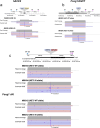Long read sequencing reveals transgene concatemerization and vector sequences integration following AAV-driven electroporation of CRISPR RNP complexes in mouse zygotes
- PMID: 40535113
- PMCID: PMC12174137
- DOI: 10.3389/fgeed.2025.1582097
Long read sequencing reveals transgene concatemerization and vector sequences integration following AAV-driven electroporation of CRISPR RNP complexes in mouse zygotes
Abstract
Over the last decade CRISPR gene editing has been successfully used to streamline the generation of animal models for biomedical research purposes. However, one limitation to its use is the potential occurrence of on-target mutations that may be detrimental or otherwise unintended. These bystander mutations are often undetected using conventional genotyping methods. The use of Adeno-Associated Viruses (AAVs) to bring donor templates in zygotes is currently being deployed by transgenic cores around the world to generate knock-ins with large transgenes (i.e., 1-4 kb payloads). Thanks to a high level of efficiency and the relative ease to establish this technique, it recently became a method of choice for transgenic laboratories. However, a thorough analysis of the editing outcomes following this method is yet to be developed. To this end, we generated three different types of integration using AAVs in two different murine genes (i.e., Ace2 and Foxg1) and employed Oxford Nanopore Technologies long read sequencing to analyze the outcomes. Using a workflow that includes Cas9 enrichment and adaptive sampling, we showed that unintended on-target mutations, including duplication events and integration of viral sequences (sometimes reported using other workflows) can occur when using AAVs. This work highlights the importance of in-depth validation of the mutant lines generated and informs the uptake of this new method.
Keywords: CRISPR; adeno-associated-virus (AAV); concatemers; long read sequencing (LRS); mice; zygotes.
Copyright © 2025 Luqman, Jenjaroenpun, Spathos, Shingte, Cummins, Nimsamer, Ittner, Wongsurawat and Delerue.
Conflict of interest statement
The authors declare that the research was conducted in the absence of any commercial or financial relationships that could be construed as a potential conflict of interest. The author(s) declared that they were an editorial board member of Frontiers, at the time of submission. This had no impact on the peer review process and the final decision.
Figures






Similar articles
-
Beyond the Cut: Long-read sequencing reveals complex genomic and transcriptomic changes in AAV-CRISPR therapy for Duchenne Muscular Dystrophy.bioRxiv [Preprint]. 2025 Aug 1:2025.08.01.668007. doi: 10.1101/2025.08.01.668007. bioRxiv. 2025. PMID: 40766352 Free PMC article. Preprint.
-
Assessing the comparative effects of interventions in COPD: a tutorial on network meta-analysis for clinicians.Respir Res. 2024 Dec 21;25(1):438. doi: 10.1186/s12931-024-03056-x. Respir Res. 2024. PMID: 39709425 Free PMC article. Review.
-
Molecular feature-based classification of retroperitoneal liposarcoma: a prospective cohort study.Elife. 2025 May 23;14:RP100887. doi: 10.7554/eLife.100887. Elife. 2025. PMID: 40407808 Free PMC article.
-
Advanced viral genome in vitro Cas9 editing (AdVICE): an overnight method for traceless and limitless manipulation of adenoviral and vector genomes with large transgenes.J Virol. 2025 Jun 17;99(6):e0226524. doi: 10.1128/jvi.02265-24. Epub 2025 May 21. J Virol. 2025. PMID: 40396759 Free PMC article.
-
Defining disease severity in atopic dermatitis and psoriasis for the application to biomarker research: an interdisciplinary perspective.Br J Dermatol. 2024 Jun 20;191(1):14-23. doi: 10.1093/bjd/ljae080. Br J Dermatol. 2024. PMID: 38419411 Free PMC article. Review.
Cited by
-
Beyond the Cut: Long-read sequencing reveals complex genomic and transcriptomic changes in AAV-CRISPR therapy for Duchenne Muscular Dystrophy.bioRxiv [Preprint]. 2025 Aug 1:2025.08.01.668007. doi: 10.1101/2025.08.01.668007. bioRxiv. 2025. PMID: 40766352 Free PMC article. Preprint.
References
-
- Bai X., Hong J. F., Yu S., Hu D. Y., Chen A. Y., Rich C. A., et al. (2024). Prevalence of errors in lab-made plasmids across the globe. bioRxiv 17, 596931. 10.1101/2024.06.17.596931 - DOI
LinkOut - more resources
Full Text Sources

